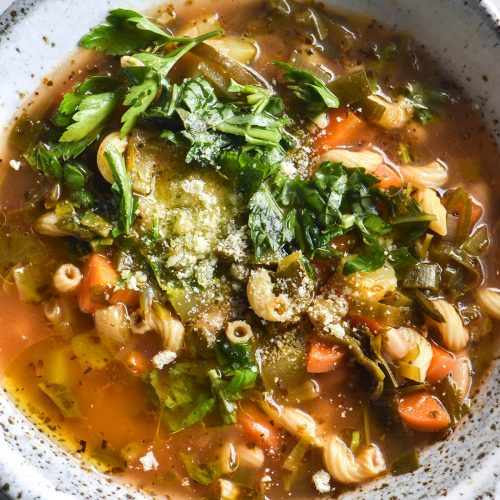
Low FODMAP minestrone
Vegan, gluten free, nut freeServes 4-6*Recipe uses Australian cups and measures. Use gram and ml for international accuracy.
Ingredients
For the garlic infused olive oil:
- 125ml (1/2 cup)* olive oil
- 1/2 - 1 head garlic cloves papery skin removed and sliced
For the soup:
- 60ml (3 tablespoons)* olive oil
- 2 leek greens thoroughly washed and sliced thinly
- 50g spring onion greens sliced
- 1/2 bunch basil soft stems and leaves (reserve remaining 1/2)
- 1/2 bunch flat leaf parsley soft stems and leaves (reserve remaining 1/2)
- 100g (4 tablespoons)* tomato paste
- 200 g carrot small cubes
- 1 zucchini small cubes
- 1 - 1 1/2 litres (1000-1250ml) water or low FODMAP vegetarian stock
- 1-2 tablespoons nutritional yeast
- 1/2 - 1 tablespoon gluten free dark miso
- 2-3 teaspoons dried sage leaves
- 2-3 teaspoons dried oregano
- 1 - 1 1/2 teaspoons salt to taste (to taste if you use stock)
- Fresh pepper to taste
- Squeeze of fresh lemon juice
- 1 x 400g can beans of choice see body of post drained and rinsed
- 100 g gluten free pasta I used mini macaroni
To finish:
- Juice of 1/2 a lemon
- Remaining herbs
- Sea salt flakes
- Vegetarian parmesan optional
Instructions
To make the garlic oil:
- Combine the oil and garlic over a low heat in a small saucepan. Cook for 5-10 minutes or just until the garlic is golden brown. Set aside to cool. Once cooled, separate the oil and garlic. You can add the crispy garlic slices to household members who can eat garlic. Allow to cool.
To make the soup:
- Heat the oil over a medium heat in a large soup pot. Once warmed, add the leek and spring onion greens and cook for 3-5 minutes until softened and fragrant.
- Add the herbs and stir to combine.
- Add the tomato paste and dried herbs and stir to combine. Allow the tomato paste to caramelise for a minute or two before adding the remaining vegetables, water or stock and remaining flavourings. Cook for however long you’d like – some minestrone cooks for hours, some until the vegetables are just tender. I prefer just tender vegetables. Do whatever you prefer, noting you might need to add more liquid (and thus perhaps more flavourings) if you cook your minestrone for a longer time.
- Take the minestrone off the heat and stir in the beans of choice and gluten free pasta. Allow the soup to sit for about 5 minutes before serving so the pasta cooks. Check that the pasta is cooked through before plating up.
To serve:
- Chop the remaining herbs finely and place them in a small bowl. Drizzle 1/4 the garlic oil over the top. Add a good squeeze of lemon (to taste) and a good pinch of sea salt flakes. This garlicky herb mix is optional but adds texture and a pop of bright flavour.
- Top each bowl of soup with the remaining garlic oil and the dressed herb mixture. Add some finely grated parmesan, if you like.
- Leftovers keep well in the fridge for a couple of days. See notes below on the pasta if you plan to have leftovers.
Notes
- Brothy soups can be trickier to add flavour to, so make sure you add as many of the flavour options as you can. Dried and fresh herbs are your best mates here.
- I have a recipe for low FODMAP vegetable stock here, if you need one. I recommend salting it only lightly so you can salt your minestrone to taste.
- Your pasta might need to cook for more or less time depending on the brand and shape. This method has worked for me with Barilla gluten free Macaroni.
If you don’t need six servings of minestrone, I recommend cooking the pasta separately and adding it fresh to each batch of soup. It goes soggy and breaks apart very easily, so cooking it separately ensures this doesn’t happen. - Whatever beans you use, make sure they are cooked before you add them to the soup. The FODMAP content of beans leeches off in the water they cook in or are canned in, so we don’t want that in our soup.
Tried this recipe?Let us know how it was!